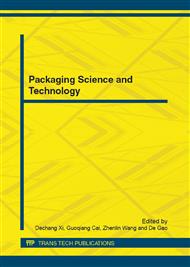p.474
p.478
p.482
p.487
p.492
p.498
p.502
p.507
p.511
Comparison Studies on Modified Atmosphere Packaging of Post-Harvest Apple
Abstract:
Modified atmosphere packaging, Transpiration, Weight loss, Apple Abstract. In the article the modified atmosphere packaging (MAP) of post-harvest apples are developed and evaluated. Firstly, the comparison package box with MAP and without package is developed and applied to make comparison experiments of post-harvest apples during storage of 30 days, 60 days and 90 days. Secondly, the influence of MAP on the transpiration of post-harvest apples is evaluated by comparison experimental studies, the respiration model and the change of water loss for post-harvest apples is analyzed. These results show that, within the initial storage of 20 days the change of water loss of apples with MAP or without package is approximate and almost linear. After 20 days of storage duration, the two cases of water loss have obvious difference, the water loss by transpiration for apples without package still shows linearity and maintain constant transpiration rate, yet the transpiration rate of apples with MAP would gradually decrease. In addition the transpiration of post-harvest apples with MAP can be effectively retarded at high relative humidity, and the post-harvest may maintain better quality and 90 days shelf life at storage condition of constant temperature 5°C and relative humidity 60%.
Info:
Periodical:
Pages:
492-497
Citation:
Online since:
October 2012
Authors:
Keywords:
Price:
Сopyright:
© 2012 Trans Tech Publications Ltd. All Rights Reserved
Share:
Citation:


